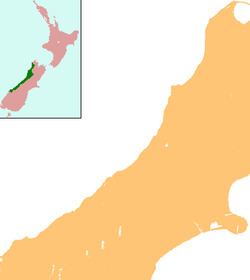Hokitika
| Hokitika | |
|---|---|
 |
|
| Coordinates: 42°42′56″S 170°58′5″E / 42.71556°S 170.96806°E | |
| Country | New Zealand |
| Region | West Coast |
| District | Westland District |
| Settled by Europeans | 1864 |
| Population (June 2016) | |
| • Total | 3,600 |
| Postcode(s) | 7810 |
| Area code(s) | 03 |
Hokitika is a township in the West Coast region of New Zealand's South Island, 40 kilometres (25 mi) south of Greymouth, and close to the mouth of the Hokitika River. According to the 2013 census, the usually-resident population of the Hokitika urban area was 2,967, a decrease of 111 people since 2006. There are 876 people living in rural Hokitika, an increase of 48 people since the 2006 Census. On a clear day Aoraki / Mount Cook can clearly be seen from Hokitika's main street.
Founded on gold mining in 1864, it was a centre of the West Coast Gold Rush. By late 1866, it was one of New Zealand's most populous centres. On 16 September 1867, there were 41 vessels alongside the wharf at Hokitika, in some places three and four deep. In 1867, the port of Hokitika ranked first in New Zealand in both the number of vessels entered inwards and in the total value of exports; principally gold.
On 8 March 1868 a mock funeral was held in protest about the conviction and hanging of three Irish Fenian's in Manchester - the Manchester Martyrs. The funeral was led by Roman Catholic Father William Larkin and a Celtic Cross was erected in the cemetery. Larkin was later arrested, charged, and convicted of riot and seditious libel.
In 1873 Hokitika became the capital of the short-lived Westland Province which lasted from 1873 until the abolition of provinces in 1876.
In October 1941, three Hokitika police officers (and a policeman stationed in the neighboring locality of Kaniere), along with a field instructor for the Canterbury education board, were killed when a local farmer, Stanley Graham, went on a shooting rampage and killed seven people, including two armed Home guard personnel.
...
Wikipedia

